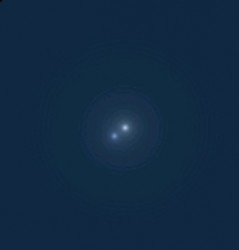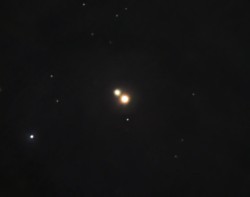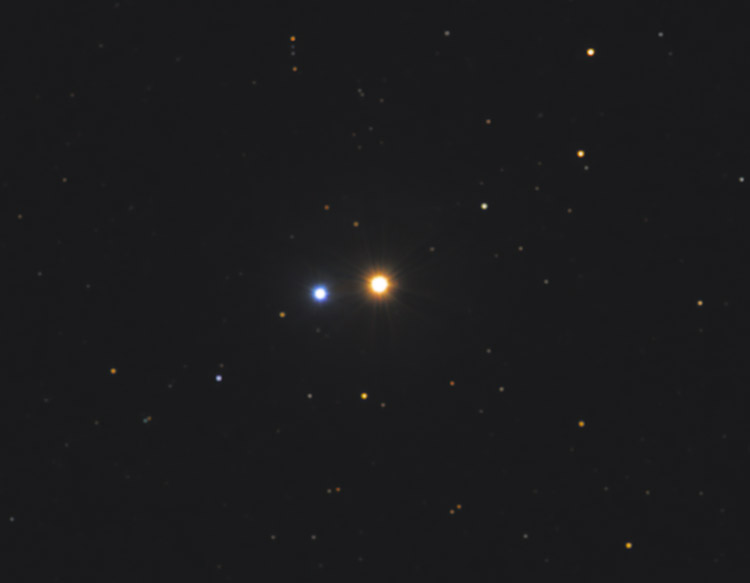[/caption]Summertime conjurs up great images of enjoying a double dip ice cream cone, and what more wonderful way to enjoy than with two flavors? Would you like to have some fun while the Moon waxes this coming week? Then invite someone along for the ride and let’s take a look at how differently people perceive stellar color!
Let’s begin with every one’s summer favorite – Beta Cygni (RA 19 30 43 Dec +27 57 34) – Albireo. This star is an easy and colorful split in both small telescopes and binoculars… Or is it? Well-noted for its color contrast, almost every person this author has shared the eyepiece with sees it differently. The primary star is often touted as a golden yellow and the secondary as blue…but, in whose eyes? While I perceive them as orange and almost purple, many folks have reported seeing no color at all, or radical differences between them,
Since my curiosity often runs high, I asked high noted astrophotographer, Dietmar Hager to photograph Albeiro to see what results he could capture on film. Without adding additional color correction, it appears to me to be near the orange and blue end of the spectrum. Now, let’s try a far less professional method and see what we come up with…


So, what do all of these stars have in common? None of them are “normal.” The A component of Cor Caroli is a magnetic and spectroscopic variable which has periodic changes in its metallic absorption lines. It is the most blue at minimum. Both the A and B stars are enveloped in an intense magnetic field. Albireo’s primary star has a composite spectrum and is actually a binary – a K-type star with a spectroscopic B-type companion. The B component of Albireo is also odd – it shows strong hydrogen absorption lines. And what of Ras Algethi? Believe it or not, the red giant primary is a variable star which is shedding a huge envelope of a gas, engulfing its B companion in the process. A companion star which itself is a binary with a composite spectrum!
Take a look at all of these stars this week before the Moon obscures their position. Albireo is the “head” of Cygnus, and Cor Caroli is the bright star located about a fistwidth away from the last star in the handle of the Big Dipper (Ursa Major). However, Alpha Herculis (south of the “Keystone”) is much more difficult to find without a starchart. For simple instructions, start at Altair (the brightest star in Aquila) and look more than a handspan west/northwest for equally bright Alpha Ophiuchi that will appear alone in the field to the unaided eye. Ras Algethi will be about 2 or 3 fingerwidths to the northwest.
Have fun and enjoy all the flavors – and colors – of summer!
These awesome binary star images of Albireo and Ras Algethi were geneoursly supplied for our inspection by AORAIA member, Dietmar Hager. Thank you for sharing the telescope with us!


About 40 to 45 years ago, I could stand in a shaded area of my back yard and at times see the Milkyway and color in some stars. (This was within the city limits of Akron Ohio (city of about 200,000.) Now I am lucky to see 1st or 2nd magnatude stars and I live about a mile farther from the center of the city.
With diffeerent people seeing different colors in the stars, perhaps cateracts could be a factor. I have cateracts that do not blur my vision but a making the lens a yellow or brown color. This would act like a yellow filter, reducing the blues a violets.
I also wonfer if the rods in the retina could be tuned a little different in different people.
Visual perception of most animals differs strongly from human seeing. For example, bees are capable to receipt in ultraviolet, some sorts of snakes percept infrared. Some nocturnal animals are more sensitive to light, while most birds of prey see sharper and magnified.
What aspects of a clear night sky they all might realize that we only can experience with the help of elaborated astronomical tools? They all should have a very different view on the stars and on that nothingness in between, which is just darkness for our eyes. Maybe their night sky sparkles in a dance of colours?
I would be very curious if we have any optometrists out there. I have asked many people over the years to tell me what they see and I find that more often than not women tend to perceive color where men do not. Young folks usually pick up on the color – but not always unless it is a deep one like Albireo.
It has been my experience with people over the years that the age distinction doesn’t seem to matter in women… women see color more frequently than men no matter what the age – while small children almost always see color!
Maybe it has more to do with the open-ness of mind than with perception… But even I have difficulty with that!
I have read where about 10% of women may possibly have an extra color receptor – which could very well be true. My peers have often accused me of having “spectra eyesight” because I can sometimes perceive things they can’t. And it isn’t because I’m a better observer – it’s just because I can see it.
What all this points out to me, is that “seeing” is all very subjective. I once asked my grand daughter if she had seen any colored stars. She replied that there was no such thing. I told her just because you don’t see it doesn’t mean it’s not there. I once had a friend who had 20/10 vision, I didn’t believe him. Then he read the small print off a sign 30 feet away, I was dumbfounded.
Many find it hard to see color in stars. Apparently, it’s harder for the eye to see color in tightly-focused objects. Try de-focusing a double star a little bit… the color jumps right out!
Not far from Ras Algethi, you’ll find another great double star: 70 Ophiuchi. It’s only 16 light year away, but the two components are close enough together to make a complete revolution in 88 years… pretty fast for a double star. The colors look gold-yellow in the brighter component, and reddish in the fainter component. Very nice!
hello folks,
Tammy, your story is intriguingly interesting!
also what you sa about your experience with people’s high varying “color-perception”-abilities happens to meet my own experiences over 20 years of public educational work in the club’s observatory (Linz).
young perceive color more easy than older people do…not only because their eyes are “fresh”, older people are biased in color-perception: this is due to individual experience as we always compare “new” things with what we have sensed in this world in our lives. the association to a certain color must therefor be different from one individual to another. “my red is not your red”,…besides a broad variation in optical physiology, including partial blindness to certain colors, different “pre-processing” in the retina (retina actually analyzes the data being cast onto it for hue, saturation and luminosity of the image. also a form of deconvolution and contrast enhancement is taking place in the retinal cells. the physiology of retianl cell-biology is still not completely revealed. but if you consider a human eye holds about 100-130 million optical sensors (you could call them pixels) it is quite clear, a pre-processing has to take place, that leads to a intelligent data reduction which is essential! otheriwse the optical nerve, that projects the data acquired in the eye to brain would have to be 130 times larger in diamter than it is! that would make our human heads quite “different” as the optical nerve would hold a diamter of about one arm! and the brain would completely overflooded and overloaded with data to analyze, as an image is created 28 times a second (smallest possible amount of assertion of human’s awareness).
and this pre-rpocessing is to be learned over a periode in our growth as children,…so again – highly variable as we are individuals.
again: my red is not your red.
best regards,
dietmar
While helping out for public nights on campus at the University of Florida, we call Albireo the Gator Star. Needless to say, all of our guests see orange and blue!
LOL! I’ve also heard it called the Michigan Star, too… But here in Oh Hi Oh, that’s dangerous!! 😉